confectionery mastic the texture is very dense, plastic, durable and is very different from any other mastic in higher quality. It is easy to make decorations for any desserts from it! Sculpting from such mastic is a real pleasure!
Ingredients for the preparation of confectionery mastic:
- Gelatin (powder) 5 teaspoons
- Water ¼ cup
- Glucose liquid ½ cup
- vegetable margarine 2 tablespoons
- Liquid glycerin 1 tablespoon
- Liquid vanilla essence half a teaspoon
- Powdered sugar 500 grams
To decorate:
- syrup sugar 30–40 milliliters
- Food coloring (yellow and green) how much will it take
- Sugar (yellow) 30-40 grams
Products not suitable? Choose a similar recipe from others!
Inventory:
- Deep aluminum bowl - 2 pieces
- Tablespoon
- Tea spoon
- Glass (capacity 240 milliliters)
- Pan
- Plate
- Fine mesh sieve
- Soup plate
- green aluminum rods
- kitchen potholder
- artistic brush
- aluminum metal spatula
- Wooden skewer - 2 - 3 pieces
- Styrofoam
- rolling pin
- Form for cookies "Heart"
- Refrigerator
- Polyethylene food film
- Set of stacks for cutting plasticine
- 300 ml jar (with sugar syrup)
Preparation of confectionery mastic:
Step 1: prepare the gelatin.
First of all, take a deep aluminum bowl and pour the right amount of gelatin powder into it.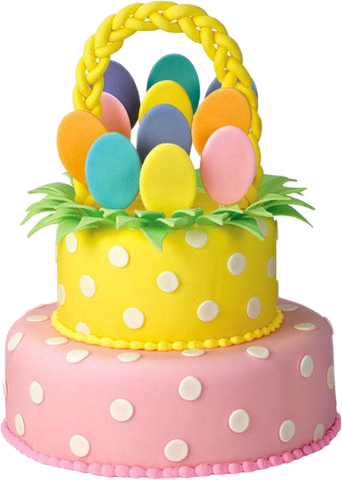 Fill it with ¼ cup of clean distilled water, previously boiled and cooled to room temperature. Then mix the mass with a tablespoon and let the ingredient soften and absorb all the liquid for 5 minutes.
Fill it with ¼ cup of clean distilled water, previously boiled and cooled to room temperature. Then mix the mass with a tablespoon and let the ingredient soften and absorb all the liquid for 5 minutes. Step 2: Melt the gelatin.
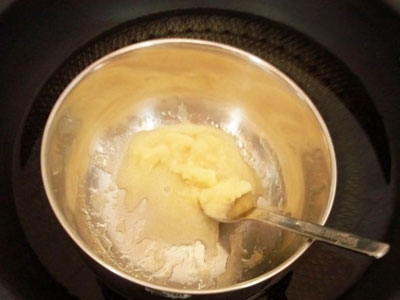 Now we take a deep frying pan, pour ordinary running water into it so that it is half filled with liquid and put the container on the stove, turned on to the middle level. When the water begins to boil slightly, place a bowl of gelatin in the pan, holding it with a kitchen tack.
Now we take a deep frying pan, pour ordinary running water into it so that it is half filled with liquid and put the container on the stove, turned on to the middle level. When the water begins to boil slightly, place a bowl of gelatin in the pan, holding it with a kitchen tack. 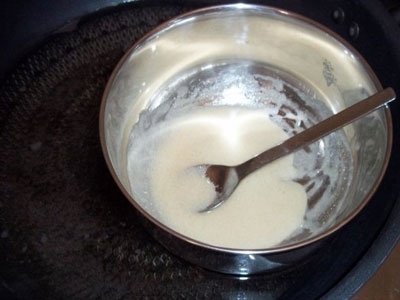 We melt the ingredient to a liquid state without lumps and grains, stirring the gelatin intensively with a tablespoon. This is the most safe way, which will help to avoid burning or hardening of this ingredient.
We melt the ingredient to a liquid state without lumps and grains, stirring the gelatin intensively with a tablespoon. This is the most safe way, which will help to avoid burning or hardening of this ingredient. Step 3: Combine all liquid ingredients.
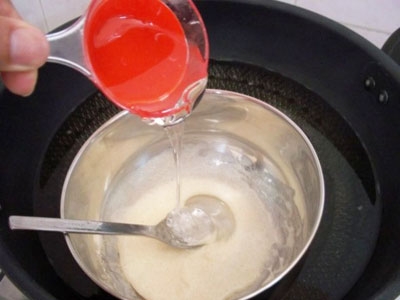 When the gelatin reaches the desired consistency, and this will happen in about 15 – 20 minutes, without removing the bowl from the water bath, add ½ cup of liquid glucose to the gelatin and continue to mix the mass with a spoon.
When the gelatin reaches the desired consistency, and this will happen in about 15 – 20 minutes, without removing the bowl from the water bath, add ½ cup of liquid glucose to the gelatin and continue to mix the mass with a spoon. 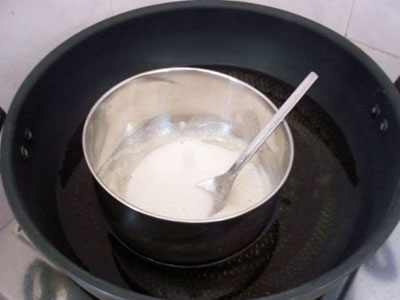 We stand the components of the mastic in a water bath for 2 - 3 minutes until they are mixed until smooth.
We stand the components of the mastic in a water bath for 2 - 3 minutes until they are mixed until smooth. 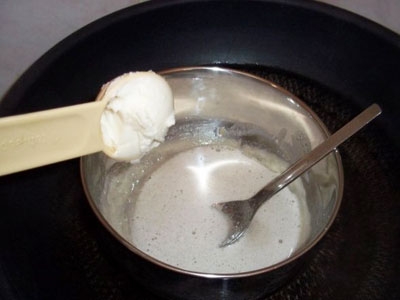 Then add 2 tablespoons of vegetable-based margarine, "Ranma" or "Korovka" is fine, but it is best to use margarine with coconut fat.
Then add 2 tablespoons of vegetable-based margarine, "Ranma" or "Korovka" is fine, but it is best to use margarine with coconut fat. 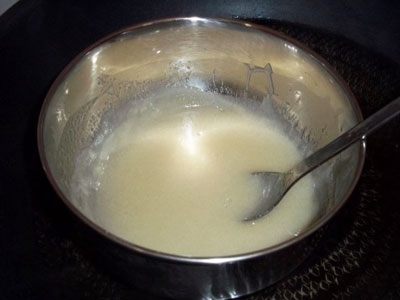 Continue to stir the ingredients until the fat is completely melted. After the liquids combine and the mass becomes uniform, remove the bowl from the water bath and put it on the kitchen table.
Continue to stir the ingredients until the fat is completely melted. After the liquids combine and the mass becomes uniform, remove the bowl from the water bath and put it on the kitchen table. 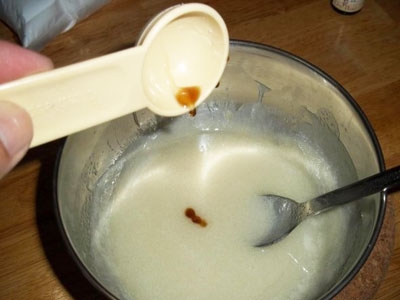 Add some liquid essence to it.
Add some liquid essence to it. 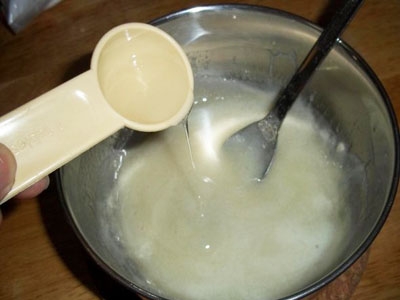 And lastly, we introduce liquid glycerin. Mix the mass with a tablespoon until smooth and set the bowl aside, allowing the liquid mixture to cool slightly, it should be warm, but not hot!
And lastly, we introduce liquid glycerin. Mix the mass with a tablespoon until smooth and set the bowl aside, allowing the liquid mixture to cool slightly, it should be warm, but not hot! Step 4: prepare the powdered sugar.
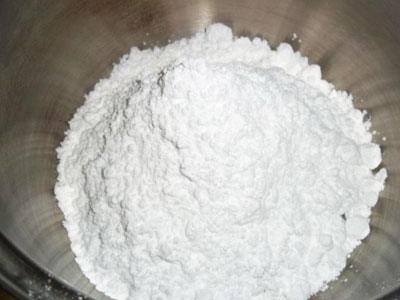 Now we take a deep bowl and sift the right amount of powdered sugar into it, this process is needed in order to get rid of the knocked down sweet lumps that are very often found in bags of powdered sugar.
Now we take a deep bowl and sift the right amount of powdered sugar into it, this process is needed in order to get rid of the knocked down sweet lumps that are very often found in bags of powdered sugar. Step 5: Knead the mastic.
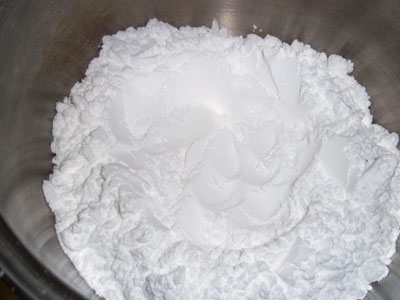 While the powdered sugar was sifted, the liquid mass cooled slightly, it's time to start kneading the mastic. In a slide of powdered sugar, make a small indentation with a clean hand.
While the powdered sugar was sifted, the liquid mass cooled slightly, it's time to start kneading the mastic. In a slide of powdered sugar, make a small indentation with a clean hand. 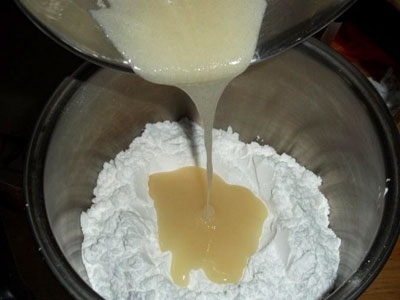 Pour into it a liquid mixture of gelatin and other important ingredients.
Pour into it a liquid mixture of gelatin and other important ingredients. 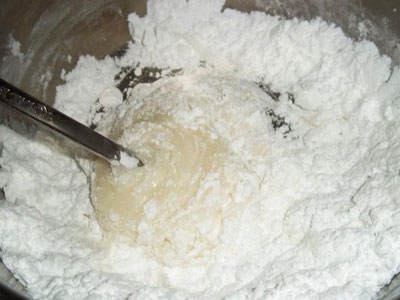 We take a tablespoon and begin to knead the mastic.
We take a tablespoon and begin to knead the mastic. 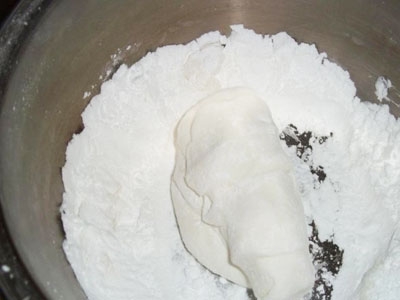 When the cutlery stops helping, and the mixture becomes thicker and thicker, continue kneading with clean and dry hands until the mastic becomes homogeneous, smooth, pliable and at the same time plastic. A little powdered sugar may remain at the bottom, it will be needed for rolling, so just pour it into a deep plate and start coloring the mastic.
When the cutlery stops helping, and the mixture becomes thicker and thicker, continue kneading with clean and dry hands until the mastic becomes homogeneous, smooth, pliable and at the same time plastic. A little powdered sugar may remain at the bottom, it will be needed for rolling, so just pour it into a deep plate and start coloring the mastic. Step 6: color the confectionery mastic.
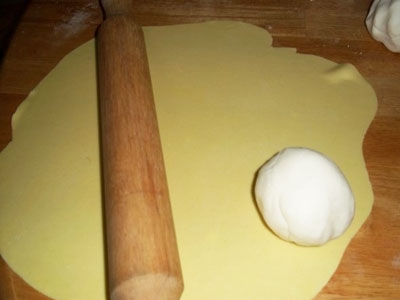 Confectionery mastic is painted like any other, for starters, using a metal kitchen spatula, we divide it into as many pieces as you want to get in the end. In this recipe, we will show you how to sculpt calla flowers and decorate a cake. Therefore, we divide the mastic into 2 parts, leave the largest one white, divide the second into 2 more parts and paint it green and yellow. This is done very simply, alternately add a drop of food coloring to each piece of mastic with a wooden skewer and then knead the semi-finished product until a uniform color. If the mastic turns out to be more than necessary, it’s not scary, it can be stored in the freezer after being wrapped in plastic wrap.
Confectionery mastic is painted like any other, for starters, using a metal kitchen spatula, we divide it into as many pieces as you want to get in the end. In this recipe, we will show you how to sculpt calla flowers and decorate a cake. Therefore, we divide the mastic into 2 parts, leave the largest one white, divide the second into 2 more parts and paint it green and yellow. This is done very simply, alternately add a drop of food coloring to each piece of mastic with a wooden skewer and then knead the semi-finished product until a uniform color. If the mastic turns out to be more than necessary, it’s not scary, it can be stored in the freezer after being wrapped in plastic wrap. Step 7: Sculpt Calla Flowers.
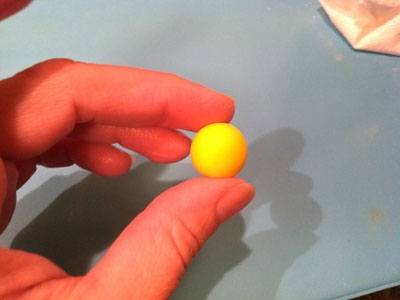 Well, now the most interesting thing, we sculpt callas, it's very easy. First, take a small piece of yellow mastic the size of a cherry and roll it into a ball.
Well, now the most interesting thing, we sculpt callas, it's very easy. First, take a small piece of yellow mastic the size of a cherry and roll it into a ball. 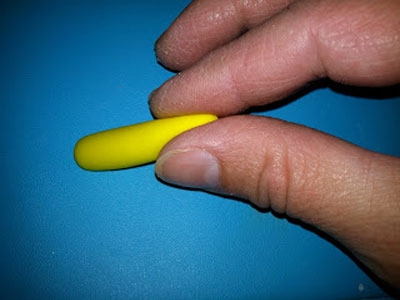 Then, with the fingers, we form an oblong “pestle” of an oval shape from it.
Then, with the fingers, we form an oblong “pestle” of an oval shape from it. 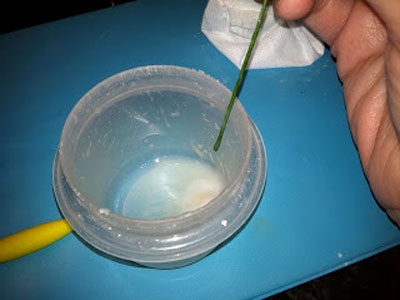 We take a piece of a green metal aluminum rod and dip its tip into a jar of sugar syrup.
We take a piece of a green metal aluminum rod and dip its tip into a jar of sugar syrup. 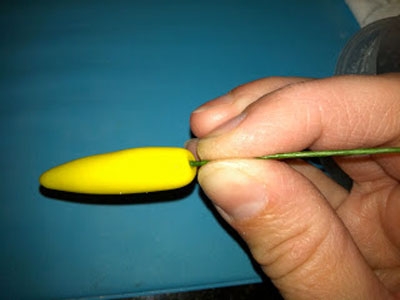 Carefully put the yellow "pestle" on the greased end of the rod.
Carefully put the yellow "pestle" on the greased end of the rod. 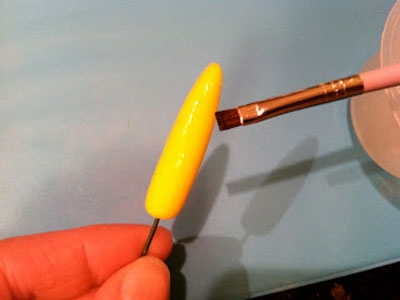 Then, using a regular art brush, we smear this piece of mastic with sugar syrup, leaving a small dry space at the bottom, on which the flower itself will be molded.
Then, using a regular art brush, we smear this piece of mastic with sugar syrup, leaving a small dry space at the bottom, on which the flower itself will be molded. 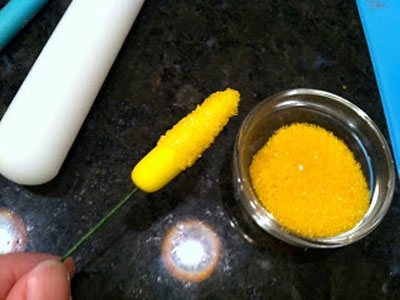 And dip the yellow "pestle" in yellow sugar.
And dip the yellow "pestle" in yellow sugar. 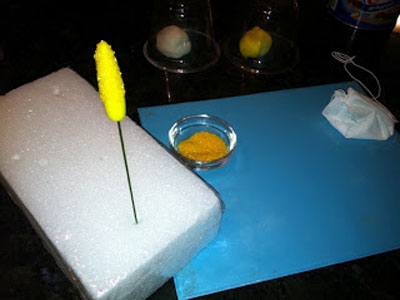 We insert a twig with a “pestle” into the foam plastic and in the same way we sculpt blanks for the rest of the flowers.
We insert a twig with a “pestle” into the foam plastic and in the same way we sculpt blanks for the rest of the flowers. 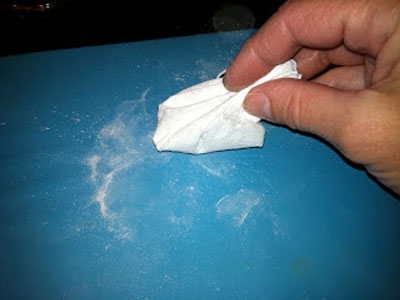 Then we sprinkle the modeling board with a small layer of powdered sugar, tear off a piece the size of Walnut and roll out the white mass with a rolling pin into a layer thick up to 1 - 2 millimeters.
Then we sprinkle the modeling board with a small layer of powdered sugar, tear off a piece the size of Walnut and roll out the white mass with a rolling pin into a layer thick up to 1 - 2 millimeters.
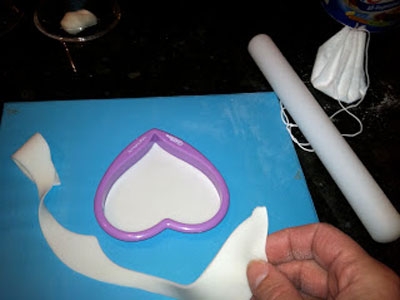 Cut out a heart shape in white fondant using a large cookie cutter.
Cut out a heart shape in white fondant using a large cookie cutter. 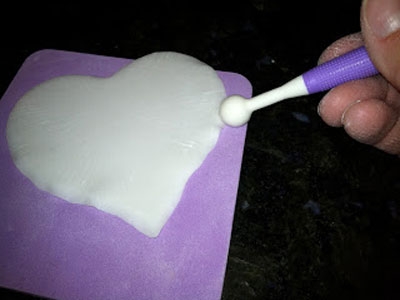 We take a stack with a rounded end and make waves along the edges of the heart.
We take a stack with a rounded end and make waves along the edges of the heart. 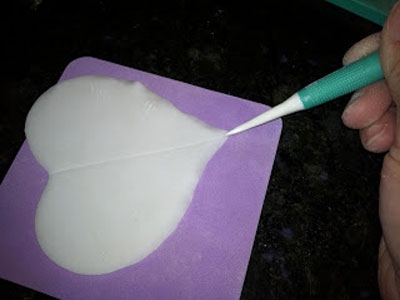 Then, using a stack with a pointed tip, we draw a small strip, starting from the sharp end of the heart and ending between the rounded halves of the heart. Now the flower will be more natural, but this process is not mandatory, you can simplify the modeling and immediately begin to form the calla.
Then, using a stack with a pointed tip, we draw a small strip, starting from the sharp end of the heart and ending between the rounded halves of the heart. Now the flower will be more natural, but this process is not mandatory, you can simplify the modeling and immediately begin to form the calla. 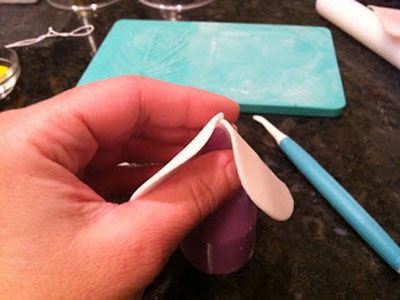 Now we take the cone-shaped nozzle, which is included in the set of stacks, set it on the table, take the white heart from the mastic and wrap it around the nozzle.
Now we take the cone-shaped nozzle, which is included in the set of stacks, set it on the table, take the white heart from the mastic and wrap it around the nozzle. 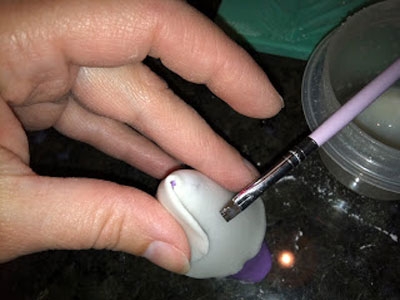 Lubricate the base of the heart at the junction with sugar syrup and lightly press the almost formed flower with your fingers so that it connects more tightly.
Lubricate the base of the heart at the junction with sugar syrup and lightly press the almost formed flower with your fingers so that it connects more tightly. 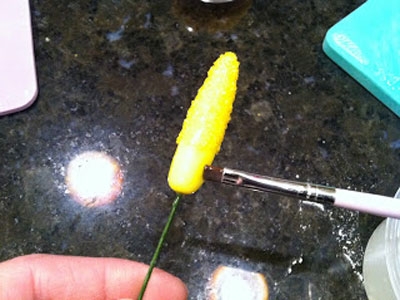 After 1 - 2 minutes, grease the lower end of the yellow "pestle" with sugar syrup.
After 1 - 2 minutes, grease the lower end of the yellow "pestle" with sugar syrup. 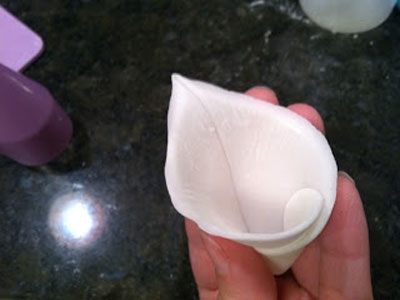 We remove the white base of the calla from the nozzle.
We remove the white base of the calla from the nozzle. 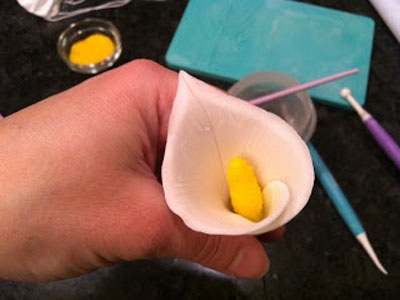 And we pass an aluminum rod with a “pestle” into it. Lightly press the bottom of the base of the flower so that the petal sits on the pistil more tightly. We form the rest of the callas in the same way. After we make leaves from green mastic using a cookie cutter, they can be large - pointed or wide - oval, as you prefer.
And we pass an aluminum rod with a “pestle” into it. Lightly press the bottom of the base of the flower so that the petal sits on the pistil more tightly. We form the rest of the callas in the same way. After we make leaves from green mastic using a cookie cutter, they can be large - pointed or wide - oval, as you prefer. Step 8: decorate the cake.
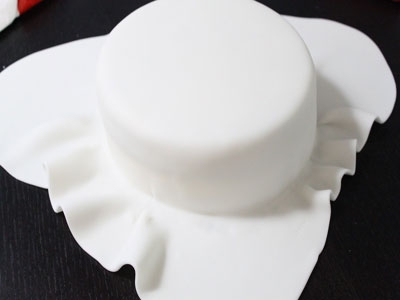 Sprinkle the countertop with a small layer of powdered sugar, and roll out the white mastic into a layer up to 2-3 millimeters thick. We transfer it to the bases for the cake smeared with cream and dress the dessert in an elegant “white coat”, prying the edges of the mastic under the bottom of the cakes.
Sprinkle the countertop with a small layer of powdered sugar, and roll out the white mastic into a layer up to 2-3 millimeters thick. We transfer it to the bases for the cake smeared with cream and dress the dessert in an elegant “white coat”, prying the edges of the mastic under the bottom of the cakes. 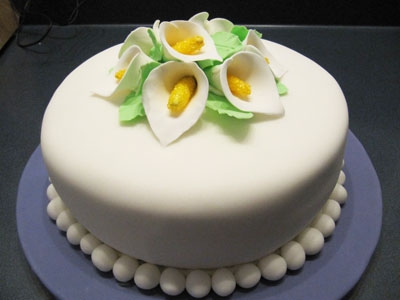 Next, we act as desired and decorate the cake with callas, as well as green leaves, come up with any composition you like.
Next, we act as desired and decorate the cake with callas, as well as green leaves, come up with any composition you like. Step 9: Serve the confectionery mastic.
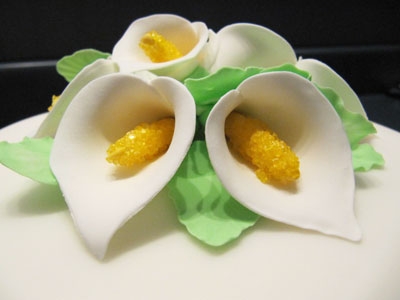 Confectionery mastic is used immediately after preparation. If leftovers remain, then it is stored in the freezer, pre-packed in plastic wrap for 1 month. From such mastic, you can sculpt not only flowers, but also any other decorations for any desserts, especially children enjoy this process! Cook with pleasure! Bon appetit!
Confectionery mastic is used immediately after preparation. If leftovers remain, then it is stored in the freezer, pre-packed in plastic wrap for 1 month. From such mastic, you can sculpt not only flowers, but also any other decorations for any desserts, especially children enjoy this process! Cook with pleasure! Bon appetit! - - Instead of vanilla essence, you can add fresh, only squeezed or concentrated lemon juice to the mastic, as well as any fruit essences in small amounts, 2-3 drops per the above mass of ingredients.
- - Do not forget that any mastic is afraid of water, so after you decorate a cake or any other dessert with this sweet mass, it is advisable to store such sweets in a dry place or in a hermetically sealed cardboard box.
- - If there is no sugar syrup at home, it is easy to prepare, just melt 100 grams of sugar with 2 tablespoons of pure distilled water in a small saucepan until a smooth, stretchy consistency. Pour the mixture into a jar and let cool completely to room temperature, then use as directed.
Confectionery mastic is a pasty elastic material, similar to plasticine, used to cover cakes, create edible decorations, flowers, shapes, and much more.
It is also known by other names: sugarpaste (sugar paste), pastillage, modelpaste, etc.
AT different countries world can be found under the following names:
The table shows that the term Fondant (fondant) is used in the USA. But in Europe and Russia, wiki fondant is another material that differs in properties from mastic in greater pliability and plasticity.
The first recipe was published in 1609 in Delights for Ladies, where a paste is made from fine white sugar, starch and wiki tragacanth gum.
First, mastic became known in the form of sweets, and then they began to use it in glazing - small cakes were dipped into a heated paste and left for a while. Decorated with these cakes big cakes. Now the mastic is cooled and applied to the cake.
In the fifth edition of Mrs. Frazer's Practice of Cookery, Pastry and Confectionery, published in 1806, the following reference is found:
“If you choose to ornament the cake, put a Crown in the middle, and other small fancy figures on the top; waving small shells up and down the sides of it, and placing within the crown a bunch of artificial flowers of different colors; the crown, figures and shells are of sugarpaste, the flowers and leaves of different colored paste, and the stalks of lemon peel".
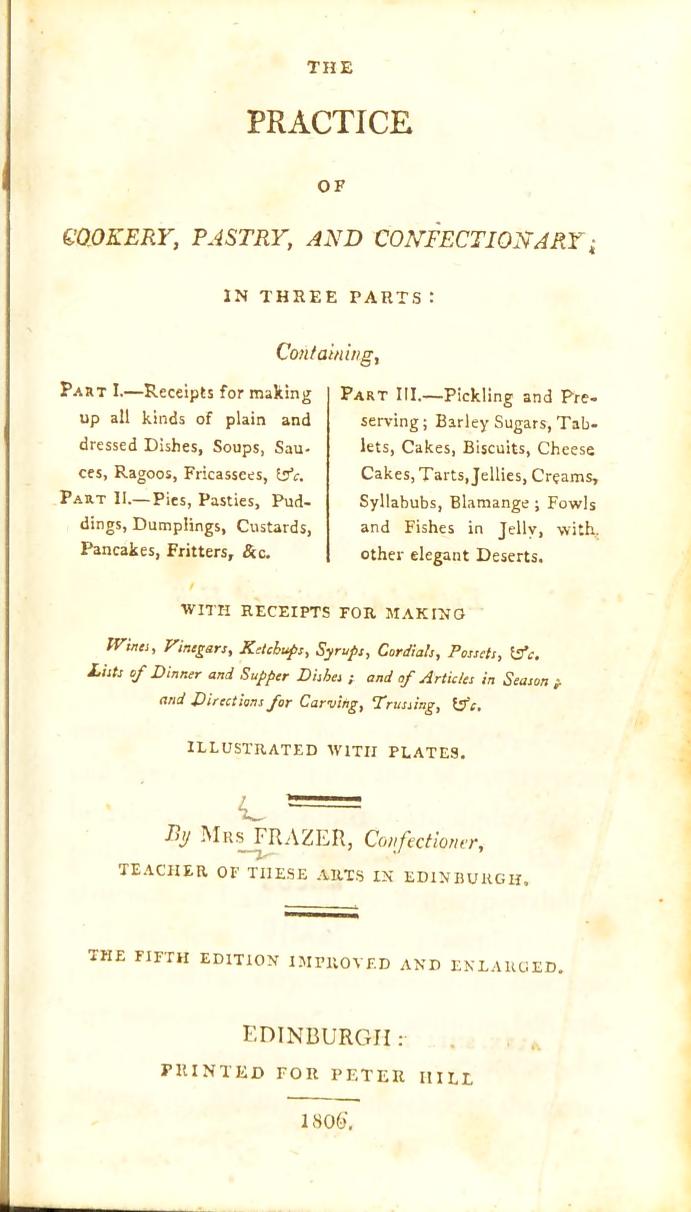
Practice of Cookery
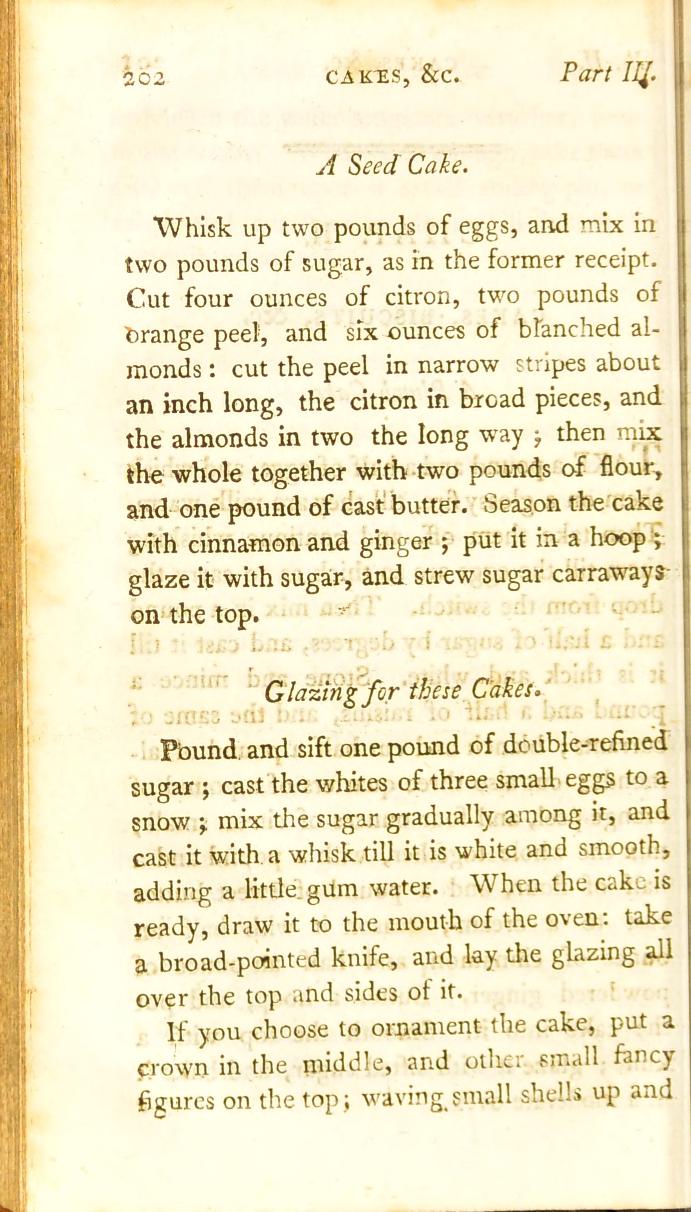
Practice of Cookery p.202
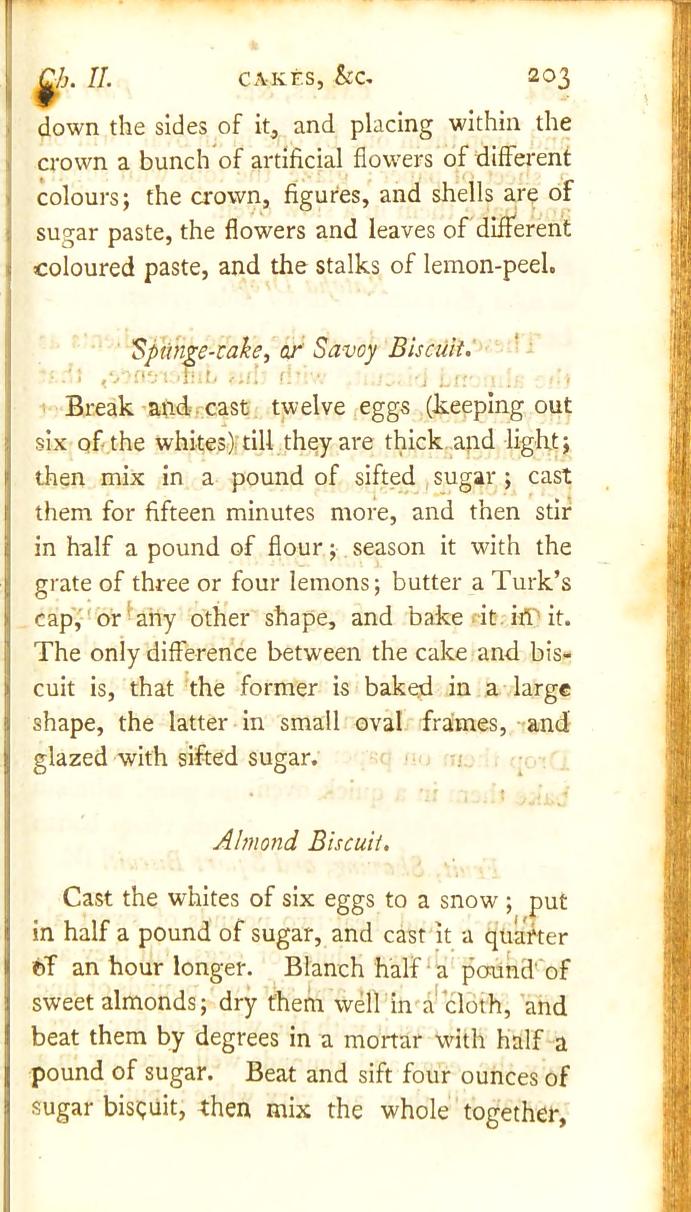
Practice of Cookery p.203
“If you decide to decorate the cake, put the crown in the middle and other small pieces on top; on either side of them, lay out small shells up and down in a wave, and also place a bouquet of flowers inside the crown; crown, figures and shells from sugar paste, flowers and leaves from multi-colored paste, and stems from lemon peel.
However, sugar paste began to be actively used only in the 20th century: 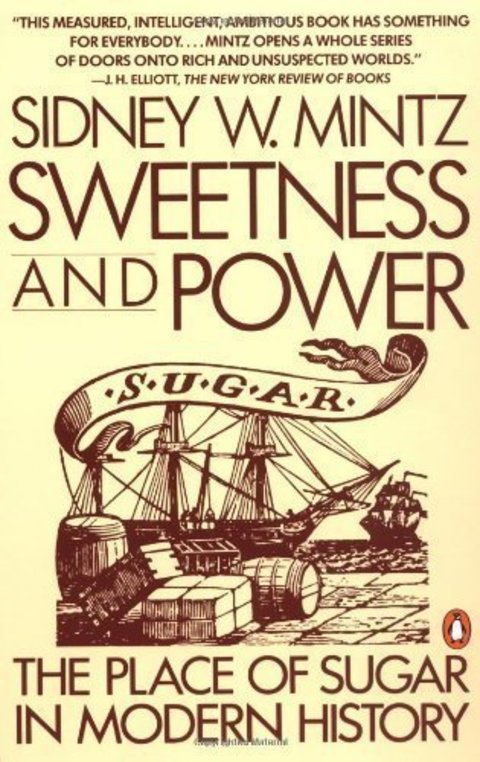 “Sugar was a luxury in Europe until the 18th century, when it became more widely available. It then became popular and by the 19th century, sugar came to be considered a necessity. This evolution of taste and demand for sugar as an essential food ingredient unleashed major economic and social changes.”
“Sugar was a luxury in Europe until the 18th century, when it became more widely available. It then became popular and by the 19th century, sugar came to be considered a necessity. This evolution of taste and demand for sugar as an essential food ingredient unleashed major economic and social changes.”
“Sugar was a luxury in Europe until the 18th century, when it became more affordable. Then it gained popularity, and in the 19th century sugar was considered a necessity. This evolution in taste and demand for sugar as an essential food ingredient has brought about major economic and social changes.”
Now mastic is one of the most demanded materials in the confectionery world. Cakes are covered with it, flowers and figures are made. There are many varieties of pasta, they differ in composition, plasticity and purpose.
Products from mastic eventually harden and become solid. The main ingredient is powdered sugar. It may also include egg white, gelatin, starch, marshmallow wiki, chocolate, honey and much more.
Industrial mastic contains glucose, due to which crystallization slows down. The following brands are represented in Russia: Wilton (USA), Pettinice (Sweden), Polen (Turkey), Top Product (Russia), Laped (Italy) and others.
Mastic can be prepared at home.
- in some recipes it is called pastilage (pastillage). Dries very quickly, ideal for creating flowers but not suitable for topping cakes.
- Gelatin - 1 tsp
- Water - 5 tbsp. l.
- Lemon juice - 10 drops
- Powdered sugar - 480 g
Pour gelatin with water and soak for 40-60 minutes. Heat the mixture on a steam bath with continuous stirring until complete dissolution. Add the rest of the ingredients and stir until done. The mastic is immediately ready for use.
- universal, suitable for covering cakes and sculpting figures.
- Powdered sugar - 500 g
- Condensed milk - 2 tbsp. l.
- Lemon juice - 2 tbsp. l.
- Infant milk formula (or powdered milk) - 4 tbsp. l. with a slide
- Potato starch - 2 tbsp. l. with a slide
Mix all ingredients. Mix well the sugar paste. Wrap in cling film and refrigerate for 1.5-2 hours.
- also universal, this is one of the most popular types of mastic.
- Marshmallow - 90 g
- Butter - 30 g
- Powdered sugar - 160 g
Melt the marshmallows and butter in the microwave for about 30 seconds. And then gradually introduce powdered sugar into the melted mass. Knead the mastic until ready.
- here, instead of powdered sugar, honey is used, so it is more pliable. Universal. One of the most delicious.
- Chocolate - 100 g
- Honey - 2 tbsp. l.
Melt chocolate with honey in a steam bath, wrap the resulting mass in cling film and refrigerate for 2 hours.
Decorations can be made in advance and stored in an airtight container in a cool, dark place, away from heat and moisture, which can soften the fondant.
If the product is thin, it dries quickly, and if it is thick, it can dry for 24 hours or more.
Mastic, unlike fondant, can be rolled out thinner, which will make the flower petals more realistic. The parts can be glued together with food glue, vodka or water. Thus, it becomes possible to create large compositions from several smaller parts.
Sugar paste can be dyed any color using food coloring.
Working with mastic resembles the work of a sculptor. Requires patience and practice.
Sources:
- Lynn Oliver. The Food Timeline. US, 1999.
- Sir Hugh Plat's. Delightes for Ladies. UK, 1609. wiki
- Lindy Smith. Sugarpaste & Fondant are they the same? UK, 2011.
- Sidney Mintz. Sweetness and Power: The Place of Sugar in Modern History. Penguin. ISBN 978-0-14-009233-2. US, 1985.
Below we will tell you how to make confectionery mastic with your own hands at home and, perhaps, having mastered the proposed recipes, you can also compete for the title of the best sweet creation.
There are a lot of recipes for confectionery mastic. Some prefer to cook it with gelatin, others from milk powder, and some combine several bases in one recipe. But all options are united by a single and irreplaceable powdered sugar, which is combined with additional ingredients that give it plasticity. Today we will focus on the recipe for making confectionery mastic from chewing marshmallow marshmallows. It is very easy to work with, it rolls out perfectly for covering cakes, and it is also very plastic when forming various shapes and patterns from it.
How to make confectionery mastic at home - recipe
Ingredients:
- small - about 3 cups;
- - 190 g;
- lemon juice - 2 tbsp. spoons.
Cooking
Pour the marshmallows into a glass bowl and put them in the microwave for twenty seconds, sprinkled with lemon juice beforehand. During this time, marshmallows should swell and double in size, so we take this into account when choosing a dish.
Now mix the marshmallows with a spoon, gradually adding the sifted icing sugar. When the mass becomes thick enough, put it on the table, after sprinkling it with a little powdered sugar, and 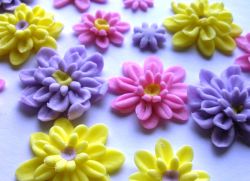 knead the mastic until it completely comes off the hands and the table, adding more powdered sugar if necessary.
knead the mastic until it completely comes off the hands and the table, adding more powdered sugar if necessary.
If there is a need to color the mastic in different colors, then we pinch off the required amount, add the gel dye and knead until a uniform color is obtained.
From multi-colored confectionery mastic, you can form beautiful flowers or make figures for a specific theme chosen for decorating the cake. Any of your idea of \u200b\u200bdecorating a product can be realized based on the recipe for making mastic described above. Of course, this will require a lot of free time and patience. And if you have both, then you will certainly succeed.
Calories, kcal:
Proteins, g:
Carbohydrates, g:
Fondant is an invention of the 16th century, which initially gained popularity in the form of sweets, and only at the beginning of the 20th century became a frequent decoration for cakes. Today, it is actively used by confectioners in combination with other types of decoration (for example, with).
Its texture is elastic, pasty and allows you to give the desired shape. It plays the role of a base-cover, providing a smooth base for further decorating the cake, it can also be used to make a border and make various decorations (cutting out shapes and figures, drawing on it or).
It should be noted that only strong cakes can support the weight of fondant, and lighter cakes (with a lack of structural integrity) cannot be used.
There are many recipes for preparing sugar mastic, so such a plastic mass can be made even at home by choosing the option you like (calorizer). In the absence of time, you can buy ready-made mastic, but only of foreign production, since it is not manufactured in Russia. It usually has the following names: gelatinous or plastic mass, fondant, modeling paste, sugar paste, gum paste, sugar paste.
It is important to know that this mass solidifies very quickly, therefore, it requires storage in a tightly closed container.
Calorie mastic sugar
The calorie content of sugar mastic is 393 kcal per 100 grams of product.
Composition of sugar mastic
The composition of the mastic is characterized by diversity, but the basis is always the same - this is. Additional components are:,. In addition, various flavors and dyes are often used.
Useful properties and harm of sugar mastic
The benefits of sugar mastic depend on its additional components, such as gelatin and marzipan.
Gelatin performs the function of repairing cartilage and protecting joints. Due to the high content of collagen, it improves the condition of hair and nails; normalizes the functioning of the central nervous system and the brain; promotes good metabolism; strengthens the heart muscle.
Marzipan also has useful properties. It contains a vitamin that helps in the fight against stress and performs the function of protecting cells from damage.
But do not use sugar mastic in large quantities. This product consists of sugar, which negatively affects the figure, teeth and the body as a whole.
Sugar mastic is a rather capricious product, so beginners should familiarize themselves with the intricacies of its use. Before work, the mastic should be thoroughly kneaded, rolled out on the table, after sprinkling or.
It is not allowed to spread it on pastry cream (calorizator). It requires a mandatory coating with a layer of biscuit or a fat-containing cream, only after that it is possible to envelop the product with mastic. Then, pre-prepared parts and figurines are placed on the cake, which are attached with a droplet. If the decorations are made of sugar mastic, then it is recommended to dry them in the open air beforehand.
Mastic is a special plastic paste that can take the desired shape, designed for modeling, that is, for decorating confectionery.
It is used in many industries, but in the confectionery it takes on a completely new color. It is used to make all kinds of decorations for confectionery.
Confectionery- this is not only sweetness and taste, it is also the refinement of appearance.
Flowers, drawings, inscriptions, figurines - all this becomes possible thanks to the skill of the masters, including the use of mastic.
According to its composition, mastic is a mixture of gelatin, powdered sugar and water, using a temperature regime.
Gelatin is mixed with water, heated, then, after straining, powdered sugar is added to the mixture and brought to a plastic state.
Dyes are added if necessary.
Confectionery dyes can be purchased, but can be made from regular foods.
So, for example, the juice of strawberries, raspberries, currants will give a red tint to the mastic, and even enhance the fruity taste.
If flavor is not desired, beetroot juice will do. An excellent solution is orange juice. It will create an orange tint and give a piquant sourness to the mastic. Green color can be added with the help of squeezed green juice.
Many have adapted to make mastic at home from chewing marshmallows (marshmallows - in other words). It is melted under the influence of high temperature, and then icing sugar, lemon juice are added. Such a mass is also very plastic, it is easy to give it the desired shape. Well, if you don’t want to do all this, there is ready-made mastic on sale.
After the mass is rolled out and shaped, the mastic product must be dried to fix this shape for several hours. Therefore, they begin to make jewelry long before the cake itself. 
Mastic is used not only for such small elements. It can cover the whole cake.
To do this, you need to roll out the mass into a thin cake, which approximately coincides in circumference with the circumference of the cake, lay it out and level it. It should lay down easily and take the shape of a cake.
Your cake is now covered in a smooth yummy that won't lose its shape and give your cake that special touch.
And to sugar mastic, covering your cake, shone, apply a layer of honey-vodka solution on it with a soft brush (honey and vodka in a ratio of 1: 1).
Don't worry, the vodka will evaporate quickly and won't affect the taste or smell of the cake in any way.
According to its taste, the mastic resembles marshmallows - in a frozen form. That is why children's cakes are most often created with the obligatory use of mastic decorations.
Many children and adults love this taste and even prefer to eat mastic as an independent product.
For special lovers, you can store this delicacy in the refrigerator, it does not lose its taste from this.
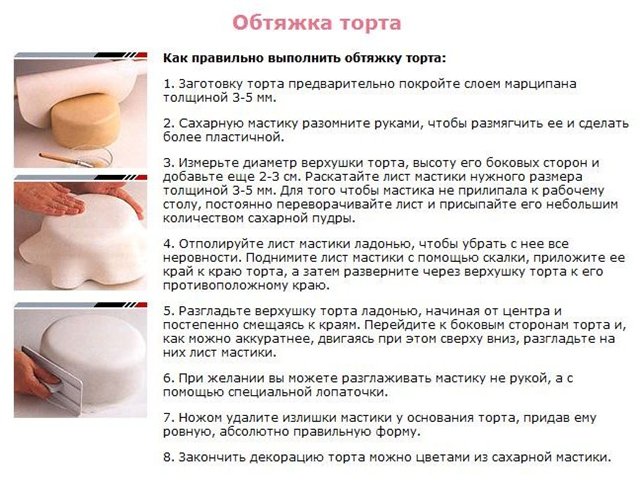 Here are a few basic rules for preparing and applying fondant cake decorations.
Here are a few basic rules for preparing and applying fondant cake decorations.
1. Most importantly, be sure to use very finely ground powdered sugar to make mastic.
If there are sugar crystals in it, then the layer will tear when rolling.
2. In no case do not cover the cake with mastic on a wet base - on sour cream, on soaked cakes, etc.
When interacting with moisture, it quickly dissolves.
Therefore, between the cake and the mastic there must be an intermediate layer. It can be like a layer of marzipan or a thin layer of buttercream.
If you decide to use butter cream, then before covering the cake with fondant, it must stand in the refrigerator until the cream hardens.
3. In order to glue different parts of the mastic figures or to glue decorations on the mastic coating, the gluing points should be lightly moistened with water or you can use protein with a little powdered sugar.
4. Volumetric decorations It is better to do it in advance so that they have time to dry thoroughly. Volumetric figures, such as bows or flowers, should be attached to the cake shortly before serving, otherwise, if they are immediately attached and the cake is put in the refrigerator, in this case the figures will absorb moisture and fall off.
5. Marshmallow decorations can be decorated with food coloring on top.
6. If the mastic has cooled down and began to roll out poorly, then you can warm it up a little in the microwave or in a hot oven, so it will again become plastic.
7. Store the remaining mastic in the refrigerator for 1 to 2 weeks, and in the freezer for 1 to 2 months, while wrapping it in plastic wrap.
8. Unused dried mastic jewelry can be stored in a tightly closed box in a dry place. You can keep them for about a couple of months.



